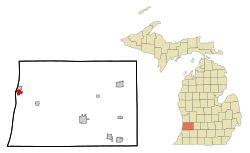Douglas, Michigan facts for kids
Quick facts for kids
Douglas, Michigan
|
|||
|---|---|---|---|
|
|||
| Motto(s):
"The Village of Friendliness since 1870"
|
|||

Location of Douglas, Michigan
|
|||
| Country | United States | ||
| State | Michigan | ||
| County | Allegan | ||
| Area | |||
| • Total | 2.01 sq mi (5.20 km2) | ||
| • Land | 1.78 sq mi (4.61 km2) | ||
| • Water | 0.23 sq mi (0.59 km2) | ||
| Elevation | 610 ft (186 m) | ||
| Population
(2020)
|
|||
| • Total | 1,378 | ||
| • Density | 774.59/sq mi (299.08/km2) | ||
| Time zone | UTC-5 (Eastern (EST)) | ||
| • Summer (DST) | UTC-4 (EDT) | ||
| ZIP code |
49406
|
||
| Area code(s) | 269 | ||
| FIPS code | 26-22740 | ||
| GNIS feature ID | 0624823 | ||
| Website | https://douglasmi.gov/ | ||
Douglas is a small city in Allegan County, Michigan. It is officially known as the City of the Village of Douglas. In 2020, about 1,378 people lived there. The city is surrounded by Saugatuck Township. The city of Saugatuck is right next to it on the north side.
In 2004, people living in Douglas voted to change its status from a village to a city. In Michigan, cities are independent, but villages are part of a larger township. This change made Douglas its own official city.
Contents
Neighborhoods in Douglas
Douglas has a few special areas, or neighborhoods:
- Beachmont is located along Lakeshore Drive, right by Lake Michigan.
- Summer Grove is found on Wiley Road. It's only about half a mile from Lake Michigan.
History of Douglas
Douglas started as a place called Dudleyville in 1851. It was a town built around sawmills, which cut down trees for wood. In 1861, the people decided to change the name to Douglas. Some say it was named after an American politician, Stephen A. Douglas. Others believe it was named by someone whose family came from Douglas, the capital of the Isle of Man. Douglas officially became a village in 1870.
The sawmills in the area were very important. They provided a lot of the wood used to rebuild the city of Chicago after the huge Great Chicago Fire in 1871. After most of the trees were cut down, the area changed. It became known for growing and shipping fruit, especially peaches. Over time, tourism and vacation resorts also became a big part of the local economy.
Geography of Douglas
Douglas covers about 1.98 square miles (5.20 square kilometers). Most of this area is land, about 1.75 square miles (4.61 square kilometers). The rest is water, about 0.23 square miles (0.59 square kilometers). The city has over 1.5 miles of shoreline along the beautiful Lake Michigan. It also has more than two miles of land along the winding Kalamazoo River and Lake Kalamazoo Harbor.
Population of Douglas
The population of Douglas has changed over the years. Here's how many people have lived there during different census counts:
| Historical population | |||
|---|---|---|---|
| Census | Pop. | %± | |
| 1880 | 522 | — | |
| 1890 | 404 | −22.6% | |
| 1900 | 444 | 9.9% | |
| 1910 | 485 | 9.2% | |
| 1920 | 305 | −37.1% | |
| 1930 | 368 | 20.7% | |
| 1940 | 421 | 14.4% | |
| 1950 | 447 | 6.2% | |
| 1960 | 602 | 34.7% | |
| 1970 | 813 | 35.0% | |
| 1980 | 948 | 16.6% | |
| 1990 | 1,040 | 9.7% | |
| 2000 | 1,214 | 16.7% | |
| 2010 | 1,232 | 1.5% | |
| 2020 | 1,378 | 11.9% | |
| U.S. Decennial Census | |||
Douglas Population in 2010
According to the census in 2010, there were 1,232 people living in Douglas. There were 645 households, which are groups of people living together. The average household had about 1.82 people. About 14% of the residents were under 18 years old. Many residents, about 26%, were 65 years old or older. The population was split evenly, with 50% male and 50% female residents.
Arts and Culture in Douglas
Douglas is famous for its many art galleries and great places to eat. You can find several well-known galleries here. Some popular spots include Water Street Gallery, LaFontsee Galleries, Button Gallery, Mr. Miller's Art Emporium, and LebenArt Gallery. These galleries show art from both local artists and artists from all over the country.
Notable Person from Douglas
- George Washington Maher - He was an important architect in the early 1900s. He was known for his "Prairie School" style of buildings.
See also
 In Spanish: Douglas (Míchigan) para niños
In Spanish: Douglas (Míchigan) para niños



